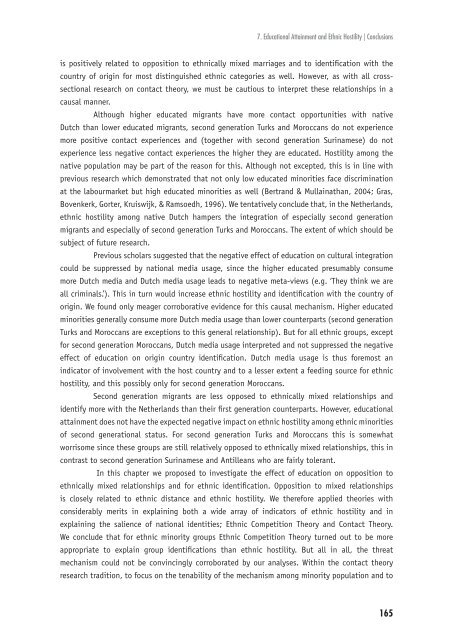Ethnic Hostility among Ethnic Majority and Minority Groups
Ethnic Hostility among Ethnic Majority and Minority Groups
Ethnic Hostility among Ethnic Majority and Minority Groups
You also want an ePaper? Increase the reach of your titles
YUMPU automatically turns print PDFs into web optimized ePapers that Google loves.
7. Educational Attainment <strong>and</strong> <strong>Ethnic</strong> <strong>Hostility</strong> | Conclusions<br />
is positively related to opposition to ethnically mixed marriages <strong>and</strong> to identifi cation with the<br />
country of origin for most distinguished ethnic categories as well. However, as with all crosssectional<br />
research on contact theory, we must be cautious to interpret these relationships in a<br />
causal manner.<br />
Although higher educated migrants have more contact opportunities with native<br />
Dutch than lower educated migrants, second generation Turks <strong>and</strong> Moroccans do not experience<br />
more positive contact experiences <strong>and</strong> (together with second generation Surinamese) do not<br />
experience less negative contact experiences the higher they are educated. <strong>Hostility</strong> <strong>among</strong> the<br />
native population may be part of the reason for this. Although not excepted, this is in line with<br />
previous research which demonstrated that not only low educated minorities face discrimination<br />
at the labourmarket but high educated minorities as well (Bertr<strong>and</strong> & Mullainathan, 2004; Gras,<br />
Bovenkerk, Gorter, Kruiswijk, & Ramsoedh, 1996). We tentatively conclude that, in the Netherl<strong>and</strong>s,<br />
ethnic hostility <strong>among</strong> native Dutch hampers the integration of especially second generation<br />
migrants <strong>and</strong> especially of second generation Turks <strong>and</strong> Moroccans. The extent of which should be<br />
subject of future research.<br />
Previous scholars suggested that the negative effect of education on cultural integration<br />
could be suppressed by national media usage, since the higher educated presumably consume<br />
more Dutch media <strong>and</strong> Dutch media usage leads to negative meta-views (e.g. ‘They think we are<br />
all criminals.’). This in turn would increase ethnic hostility <strong>and</strong> identifi cation with the country of<br />
origin. We found only meager corroborative evidence for this causal mechanism. Higher educated<br />
minorities generally consume more Dutch media usage than lower counterparts (second generation<br />
Turks <strong>and</strong> Moroccans are exceptions to this general relationship). But for all ethnic groups, except<br />
for second generation Moroccans, Dutch media usage interpreted <strong>and</strong> not suppressed the negative<br />
effect of education on origin country identifi cation. Dutch media usage is thus foremost an<br />
indicator of involvement with the host country <strong>and</strong> to a lesser extent a feeding source for ethnic<br />
hostility, <strong>and</strong> this possibly only for second generation Moroccans.<br />
Second generation migrants are less opposed to ethnically mixed relationships <strong>and</strong><br />
identify more with the Netherl<strong>and</strong>s than their fi rst generation counterparts. However, educational<br />
attainment does not have the expected negative impact on ethnic hostility <strong>among</strong> ethnic minorities<br />
of second generational status. For second generation Turks <strong>and</strong> Moroccans this is somewhat<br />
worrisome since these groups are still relatively opposed to ethnically mixed relationships, this in<br />
contrast to second generation Surinamese <strong>and</strong> Antilleans who are fairly tolerant.<br />
In this chapter we proposed to investigate the effect of education on opposition to<br />
ethnically mixed relationships <strong>and</strong> for ethnic identifi cation. Opposition to mixed relationships<br />
is closely related to ethnic distance <strong>and</strong> ethnic hostility. We therefore applied theories with<br />
considerably merits in explaining both a wide array of indicators of ethnic hostility <strong>and</strong> in<br />
explaining the salience of national identities; <strong>Ethnic</strong> Competition Theory <strong>and</strong> Contact Theory.<br />
We conclude that for ethnic minority groups <strong>Ethnic</strong> Competition Theory turned out to be more<br />
appropriate to explain group identifi cations than ethnic hostility. But all in all, the threat<br />
mechanism could not be convincingly corroborated by our analyses. Within the contact theory<br />
research tradition, to focus on the tenability of the mechanism <strong>among</strong> minority population <strong>and</strong> to<br />
165












